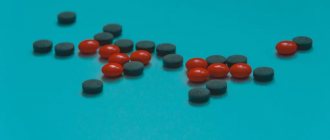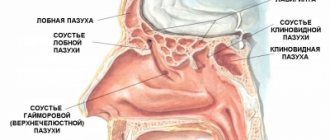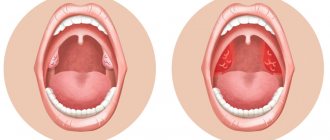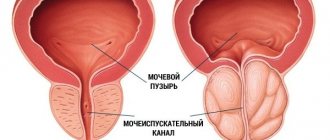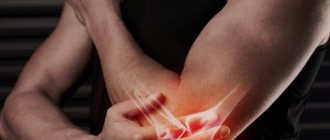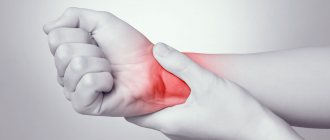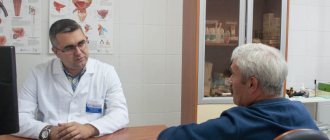Inflammation of the prostate today is a leader in the group of male diseases that are predominantly sexually transmitted. Its complications threaten infertility, decreased libido, and impotence.
Symptoms of prostatitis are not just pain, urination disorders, and inflammation of the spermatic cord. The most dangerous consequence of advanced inflammation can be cancerous degeneration of the prostate gland. Whereas a timely diagnosed pathological process is easily stopped.
Causes of inflammation
The risk of developing prostate inflammation increases due to various factors predisposing to the disease:
- Hypothermia, one-time or associated with the nature of work in the open air.
- A sedentary lifestyle leads to disruption of the functioning of the digestive system.
- Chronic somatic diseases (diabetes mellitus, hypertension).
- Foci of focal, perifocal infection (rhinitis, tonsillitis, stomatitis, gastritis).
- Persistent UGI (chlamydia, trichomoniasis, herpes virus).
- Stress, insomnia, chronic fatigue syndrome.
- Decreased immunity due to illness, surgery, emotional stress.
- Bad habits leading to the development of intoxication: alcohol, smoking, strong coffee.
- Occupational injuries to the perineum of car drivers, athletes, workers in hazardous industries.
- Promiscuous sex life, interrupted sexual intercourse, devoid of sensuality intercourse with incomplete ejaculation, prolonged absence of intimacy (low need for sperm leads to stagnation in the gland).
- Venereal diseases.
Despite a fairly large number of provocative moments, the essence of prostatitis is the occurrence of stagnation inside the organ against the background of impaired blood circulation and lymph outflow.
Factors contributing to the development of prostatitis
Among the predisposing circumstances, the following are noted:
- regular hypothermia of the body;
- irregular sexual activity;
- diseases associated with immune system disorders;
- chronic pathologies of the genitourinary system;
- sedentary lifestyle – lack of physical activity, sedentary work;
- pelvic organ injuries;
- other chronic pathologies of the gastrointestinal tract, ENT organs, and so on.
There is an opinion among experts that the risk of developing symptoms of bacterial prostatitis in men increases with intoxication factors. These include abuse of alcohol, nicotine, and narcotic substances.
Classification
In modern urology there is no uniform classification of the disease. However, practicing doctors prefer this option for classifying the inflammatory process in the prostate:
- According to the course of the disease:
- Acute prostatitis. It accounts for more than 50% of cases of the disease in people no older than 30-35 years.
- Chronic option. It is considered a non-age category. It does not manifest itself for a long time; the impetus for its development is a cold or infection.
- For the reason that caused the pathology:
- Bacterial inflammation of the prostate gland, predominates in men under 40 years of age, occurs against the background of ultrasonography, and does not extend beyond the boundaries of the organ.
- Non-bacterial pathological changes in the gland, predominantly chronic.
- Viral inflammation of the prostate is characterized by an acute course that affects the entire genital area.
- Fibrous prostatitis is characterized by rapid irreversible growth of the gland and requires radical intervention. Clinically resembles prostate adenoma.
- Calculous inflammation of the prostate gland occurs due to the formation of stones inside the prostate. Considered as a harbinger of cancer.
- Congestive prostatitis, the result of a sedentary lifestyle, is diagnosed in every second patient.
Epidemiology
Prostatitis is one of the most common diseases in men. It has a significant impact on performance and family relationships. The quality of life of patients decreases to the same extent as in people who have had a heart attack or suffer from angina pectoris.
According to data from various sources, every 3rd or 4th man is diagnosed with prostatitis. And most often this is not the initial or acute stage of the disease, but an already formed and long-term process - chronic.
Not so long ago, it was generally accepted that this pathology is characteristic mainly of older men. But statistical data refuted this opinion. Today it is known that chronic prostatitis is a disease of men of childbearing age who are sexually active.
More than 30% of patients consult a specialist with complaints characteristic of chronic prostatitis. Often, at the time of a visit to the doctor, the disease is complicated by concomitant pathologies: erectile dysfunction, vesiculitis, primary or secondary infertility, epididymitis.
Signs of the disease
If a man discovers at least two of the following symptoms of prostatitis, he should immediately contact a qualified specialist:
- Disorder of urination with the occurrence of an intermittent, weak stream of urine, unusually short, causing splashing, difficulty and pain before urination. Frequent urge to empty the bladder occurs mainly at night.
- Soreness, which is localized in the lower abdomen, radiates to the scrotum, perineum, and rectum.
- Sexual dysfunction.
- Problems with ejaculation, changes in sperm (consistency, quantity).
What's the result?
Prostatitis is a disease of the prostate gland in which the patient complains of pain in the pelvic area, difficult or painful urination and/or painful ejaculation. If any of these three symptoms appear, you should consult a doctor as soon as possible.
Bacterial prostatitis is treated with antibiotics and drugs that improve urination. The duration of treatment is usually from 2 to 4 weeks. The effectiveness of prostate massage and physical therapy has not been proven.
To avoid prostatitis, you need to strive to have regular sex life, do not forget about condoms and avoid severe hypothermia.
Acute prostatitis
The disease begins with a sharp rise in temperature (up to 40 degrees), painful headache, and fever. The symptoms that appear are accompanied by pain in the groin, perineum, back, discharge from the urethra, frequent urination and a constant urge to urinate.
Emptying the bladder occurs with a delay and a burning sensation. The urine itself becomes cloudy and may contain blood. Irritability and fatigue occur.
The outcome of acute prostatitis can be complete resolution of the process (if treatment is started in a timely manner). Since changes occur in many pelvic organs, they cannot be left to chance, otherwise the corresponding complications will arise:
- Vesiculitis is an inflammation of the seminal vesicles, the cause of the appearance of pus in the sperm, which not only reduces the quality of the ejaculate, but leads to loss of reproductive function.
- Colliculitis - inflammatory changes in the seminal tubercle become the reason for the development of severe pain during sex, interruption of orgasm, and impotence of a psychological nature.
- The formation of an abscess in the body of the prostate, its rupture, and purulent damage to the rectum leads to an exacerbation of symptoms, severe intoxication of the body, even death.
- Stagnation in the tissues of the prostate leads to changes in their structure, disruption of innervation, blood supply, both to the gland itself and to organs located nearby, with disruption of their functions. The erection becomes insufficient for full sexual intercourse, premature ejaculation and prolonged sexual intercourse without orgasm are observed.
- Cicatricial changes in the gland and spermatic cord lead to infertility, a decrease in the quality of sperm, and sperm motility. Narrowing of the urethra interferes with the normal process of urination; obstruction of the bladder can cause acute urinary retention, requiring emergency surgical care.
Types of disease
There are several types of classification of the disease, depending on the symptoms, etiology, nature and duration of the course, relapses, and other associated factors.
When determining the type of bacterial prostatitis in men, the following parameters are taken into account:
- cause – infection, bacteria;
- the type of pathogenic agent that caused the inflammation;
- the presence of stagnation of secretions and ejaculate;
- fibrotic manifestations;
- route of infection;
- specificity of the course - acute, chronic, atypical form;
- phase of activity of the inflammatory process;
- development stage.
Most often, the algorithm proposed by American scientists from the National Institutes of Health is taken as the basis for classification.
| Category | Type of prostatitis | Specifics |
| I | Acute bacterial | Presence of acute inflammatory process |
| II | Chronic bacterial | Relapsing course of the disease |
| III | Chronic pelvic pain syndrome | Presence of pain for at least 3 months |
Chronic prostatitis
The main feature of the disease is the vagueness of clinical symptoms with a long, persistent course of the process. More often, the chronic form occurs independently, as a primary pathology against the background of stagnation of blood in the vessels (prostatosis), abacterial prostatitis.
The main symptoms of chronic prostatitis are:
- fever;
- pain occurs in the scrotum, perineum, anus, back;
- urinary disturbance;
- mucous or mucopurulent discharge from the rectum, urethra, even in the absence of urination or defecation;
- erectile dysfunction, painful ejaculation, interrupted sexual intercourse, prolonged intercourse without a feeling of satisfaction.
Inaction and improper treatment of chronic prostatitis can cause complications:
- Infertility is the result of chronic inflammation in the spermatic cord, vesicles, testicles, and their appendages.
- Cystitis, pyelonephritis (other diseases of the genitourinary system) are a consequence of hematogenous and mechanical spread of microbes.
- Sepsis.
- Persistent decrease in immunity.
- Untreated prostatitis can cause cancer in 35–40% of cases.
Nutrition
This factor also plays a big role; a proper diet will help you recover faster from illness and reduce the risk of relapse. It is recommended to select food according to the following principles:
- products containing all the microelements necessary for the body;
- food should be well digestible and not heavy;
- foods high in fiber stimulate the digestion process and prevent intestinal dysfunction;
- Monitoring your drinking regime will help prevent dehydration.
The main task when creating a diet is to normalize intestinal function, since constipation is one of the causes of exacerbations of prostatitis.
Diagnostics
The clinical picture of the disease is typical, so the diagnosis is not difficult. It is performed by a urologist based on medical history, examination of the patient, laboratory minimum using the most modern medical devices:
- Rectal examination of the gland, taking secretions for examination (culture with determination of sensitivity to antibiotics).
- UAC, UAM, bacterial culture of urine.
- Smear test for STDs, UGI examination.
- Daily monitoring of urination rhythm, measurement of urination rate (uroflowmetry).
- For differential diagnosis, ultrasound or TRUS is performed.
- If it is necessary to exclude oncology, a biopsy is taken, urography is performed, and PSA is determined - prostate specific antigen.
- To diagnose infertility, a spermogram is prescribed - an analysis of ejaculate to determine the fertility of a man.
Based on the results of the patient’s examination, an individual scheme for complex treatment of prostatitis is drawn up. When prescribing drugs, the form of the pathology and the presence of concomitant diseases are taken into account. The decision about where to conduct therapy (inpatient or outpatient) is made by the doctor. The course of treatment is carried out with careful laboratory monitoring of results.
One of the most modern centers for the treatment of prostatitis are the clinics of the Mother and Child Group of Companies. Since the problem of infertility is closely related to inflammatory urological diseases, medical professionals pay great attention to this problem.
In the Mother and Child clinics, each patient has the opportunity to undergo a full cycle of special examination, receive psychological support, be treated with the latest generation drugs used in this area, and become familiar with the latest methods for treating prostate inflammation. Not least important in the complex therapy of prostatitis is the issue of effective rehabilitation of patients, clinical observation, and prevention.
Bacterial prostatitis (BP) is a common disease characterized by a relapsing course and having a pronounced negative impact on the quality of life of patients. The disease is more often diagnosed in young people during the period of greatest sexual activity and is often complicated by impaired copulatory and reproductive functions [1–3].
In terms of incidence, chronic prostatitis competes with such common prostate diseases as benign hyperplasia and prostate cancer [4]. In the reports of the US National Ambulatory Medical Service for 1990-1994. provides data on the annual diagnosis of prostatitis in 2 million Americans. In the middle of the last century, every month each urologist in the United States provided care to an average of 173 patients with prostatitis [5], while in Canada the value of the same indicator was 22 patients, of whom in 38% of cases the diagnosis was made for the first time [6].
According to a study by the Canadian Medical Center, 9.7% of surveyed men aged 20–74 years experienced discomfort in the perineum or during ejaculation in combination with pain [7].
According to some authors, in patients 60 years of age and older, prostatitis occurs 1.6 times more often than at the age of 18-35 years, 2.6 times more often than at the age of 36-50 years and 2.1 times more often than at 51–65 years [8].
There are the following routes of infection of the pancreas:
- ascending urethrogenic;
- urethro-prostatic reflux;
- urethrovenous reflux;
- hematogenous;
— lymphogenous;
- direct invasion by intestinal bacteria (during anal sexual intercourse);
- endourethral.
The implementation of the lymphogenous pathway is possible in the presence of an inflammatory process in the pelvic organs, hematogenous - due to the anatomical and physiological characteristics of the blood supply to the pancreas (widely developed venous and arterial anastomoses that promote the adhesion of microorganisms in the gland) [9].
Invasion of infectious agents into pancreatic tissue can lead to the development of serous, catarrhal, purulent, purulent-hemorrhagic inflammatory processes, depending on the type of microflora, its virulence, as well as the state of immunological reactivity and nonspecific resistance of the macroorganism [10].
A number of clinical classifications of prostatitis have been developed. However, most authors [11] use the classification proposed in 1995 by the US National Institutes of Health (Table 1).
In accordance with this classification, BP belongs to category I or category II. The diagnosis of PD is based on the identification of proven etiological agents (Table 2).
According to the World Health Organization International Expert Council on Prostate Diseases, the etiology of abacterial prostatitis/chronic pelvic pain syndrome has not been established [12].
According to a systematic review of studies on the role of “atypical” prostatitis pathogens, the authors [13] concluded that the detection of C. trachomatis or U. urealyticum in the three-glass test is not evidence of their etiological role in the development of chronic prostatitis/chronic pelvic pain syndrome, since as it is not possible to differentiate the localization of the pathogen in the urethra and pancreas.
The routes of infection spread in chronic PD (CKD) are similar to those in the acute form of the disease. Often a chronic inflammatory process is the result of unresolved acute prostatitis, but often there are no such indications in the patient’s medical history.
Clinical symptoms of PD
Symptoms of CKD are usually less severe than those of acute inflammatory disease and have considerable variability. The patient's medical history often contains indications of past urogenital infections, including gonococcal etiology. CKD can develop simultaneously with recurrent urinary infection, and therefore topical diagnosis is important. The leading symptoms of the disease are pain in the perineum, dysuria, urethral discharge, and recurrent urinary tract infection.
According to DH Zermann et al. [14], pain in the perineum is observed in 46% of patients, in the scrotum - in 39%, in the bladder - in 6%, in the penis - in 6%, in the lower back - in 2% of patients. A significant number of patients have dysuria - frequent, painful, difficult urination [14]. During a digital rectal examination of patients with chronic prostatitis, pastiness, swelling of the gland, blurred contours, smoothness of the median groove, and moderate pain are noted. Urine examination reveals bacteriuria and leukocyturia.
The US National Institute of Health has proposed a questionnaire to assess the severity of clinical symptoms - the “Chronic Prostatitis Symptom Index”, which contains 3 categories - pain and discomfort, dysuria, impact on the quality of life of patients, and allows for a quantitative assessment of the leading symptoms of the disease during treatment and further dynamic observation [15].
Diagnosis of BP
The diagnosis of chronic prostatitis is established on the basis of anamnestic data, assessment of objective and subjective symptoms of the disease, results of digital rectal examination of the prostate, analysis of data from laboratory methods for studying clinical material of the urethra, prostate secretion and urine.
Proposed in 1968 by E. Meares et al. [16] The 4-glass urine sample has become standard in the diagnosis of prostate disease. The first 10 ml of freely excreted urine (1st portion) reflects the state of the urethral microbiocenosis; the late middle part of urine (2nd portion) contains material from the bladder. Then, after a prostate massage, prostate secretion is obtained (3rd portion; it is not recommended to obtain prostate secretion in acute PD). Normally, pancreatic secretions should contain less than 10–12 leukocytes per field of view. In the presence of an inflammatory process in the pancreas, macrophages are often detected. After massaging the prostate and obtaining its secretion, 10 ml of freely excreted urine is also examined (4th portion). Before conducting a 4-glass test, it is not recommended to prescribe antibacterial drugs during the previous 3–4 weeks. The obtained samples of urine and prostate secretion are examined using microscopic and cultural methods.
Microscopic examination of prostate secretion is especially important in the diagnosis of chronic prostatitis. Determine the presence of leukocytes, erythrocytes, lecithin grains, amyloid bodies, epithelial cells, as well as T. vaginalis
and gram-negative gonococci. If chronic prostatitis is suspected, the examination of prostate secretions should be repeated if there have been no changes in the latter.
Determining the content of lecithin grains in the secretion (normally 20-40 per field of view), which are a specific product of the gland epithelium, also has diagnostic value. A decrease in the content of lecithin grains in secretions in chronic prostatitis serves as an additional diagnostic criterion.
Bacteriological examination of prostate secretion and determination of the sensitivity of the isolated microflora to antibacterial drugs is necessary to establish the etiology of chronic prostatitis and select adequate therapy.
Transrectal ultrasonographic examination allows us to identify structural changes in the prostate characteristic of CKD - foci of sclerosis, stones, prostate cysts, as well as to carry out a differential diagnosis of prostatitis with hyperplasia and prostate cancer. To determine the state of the vascular bed of the pancreas and periprostatic tissue, the Doppler sonography method is widely used, the significance of the results of which should be assessed only in combination with the data of a clinical and laboratory examination.
A study of the functional state of the bladder is carried out in patients with CKD with urinary disorders. Urofluometry can detect a decrease in the maximum and average volumetric flow rates of urine. To establish the cause of urination disorders, in particular bladder outlet obstruction, and to exclude neurogenic bladder dysfunctions, a combined urodynamic study is indicated. Most often, signs of pseudodyssynergia of the external sphincter and detrusor instability are detected [1, 17].
Treatment of PD
Approaches to the diagnosis and treatment of PD are formulated in modern international documents: Recommendations of the VI International Consultations on the Development of New Directions in the Treatment of Cancer and Prostate Diseases (2006), recommendations of the European Association of Urology (2010), recommendations of the International Advisory Council on Urological Diseases (2010).
Priority in the conservative treatment of CKD is given to antibacterial therapy, the choice of which is determined by the following factors:
— etiology of the inflammatory process;
— the ability of drugs to penetrate the tissue and secretions of the pancreas to create a bactericidal concentration;
— spectrum of antimicrobial activity of drugs.
Antibacterial drugs of different pharmacological groups differ in their ability to create a certain level of concentration in prostate secretions and tissue. Preference is given to drugs with high fat solubility, which are in a non-ionized state, with a low degree of binding to blood plasma proteins, which have the ability to translocate through the lipid membranes of prostate epithelial cells, active in an alkaline environment. Fluoroquinolones have a high degree of diffusion into prostate tissue, the effectiveness of which, including the elimination of microorganisms, reaches 90% or more [18].
In accordance with international approaches, the following treatment regimens for PD are recommended (Table 3).
In addition to antibacterial therapy, α1-blockers are prescribed to reduce the severity of dysuria.
Often, treatment of CKD with antibacterial drugs is ineffective, which a number of researchers explain by disturbances in the pharmacokinetics of drugs in the tissue of the inflamed prostate. When studying the characteristics of the pharmacokinetics of norfloxacin in the tissue of inflamed and non-inflamed pancreas of experimental animals (rats) using Escherichia coli
No significant differences in drug concentration levels were found [19]. The authors concluded that the ineffectiveness of treatment for CKD may not be due to changes in the pharmacokinetics of the drug in the inflamed prostate tissue, but to the formation of biofilms in the prostate tissue that are “protected” from the effects of antibiotics.
Biofilms are special bacterial structures adhered to the surface of mucous membranes. Low effectiveness of treatment of infectious and inflammatory processes caused by microorganisms that form biofilms has been established, which manifests itself in the development of persistent infection [20].
In CKD, using scanning electron microscopy, it was possible to detect the phenomenon of biofilm formation on the surface of the ductal epithelium, which, according to the authors, may explain the ineffectiveness of antimicrobial therapy [21].
The significance and properties of biofilms have not been sufficiently studied, however, it has been demonstrated that microorganisms that form microbial communities, without changing individual sensitivity, are characterized by significant resistance to antibacterial drugs [22].
In recent years, the results of studies have been published on the effectiveness of complex treatment of infectious and inflammatory diseases using systemic enzyme therapy.
Based on data from a double-blind, placebo-controlled study performed on healthy volunteers, a dose-dependent increase in serum proteolytic activity was demonstrated with enteral administration of proteolytic enzymes [23].
Many studies have been devoted to studying the effectiveness of systemic enzyme therapy in the treatment of PD (Table 4).
According to a study by V.N. Tkachuk et al. (2007), the concentration of a fluoroquinolone antibiotic in the tissues of the prostate gland against the background of combined treatment with antibiotic + Wobenzym in patients with chronic prostatitis, obtained by transrectal biopsy of the prostate 2 hours after oral administration, was significantly higher in the ejaculate (p <0.05) and in prostate tissues (p<0.01) than with antibiotic monotherapy. Thanks to the inclusion of Wobenzym, microcirculation in the inflammation site significantly improved (the diastolic blood flow velocity in the arteries of the gland increased on average 1.5 times and the average linear blood flow velocity in the vessels increased 1.4 times), providing a higher concentration of the antibiotic in the inflammation site, reducing swelling of the gland , and therefore reducing pain.
Along with those presented in table. 4
and other clinical studies conducted a pharmacoeconomic analysis of the effectiveness of treatment of patients with chronic prostatitis with the inclusion of systemic enzyme therapy (
Wobenzym
) in the treatment complex.
It has been shown that the cost-effectiveness ratio is lower in patients receiving antibacterial treatment in combination with Wobenzym
compared to antibiotic monotherapy [24].
A very relevant and interesting experimental study devoted to the study of the effect of various enzymes on the formation of biofilms of gram-positive and gram-negative microorganisms was carried out by V.V. Tetz et al. They established the ability of certain enzymes that make up Wobenzym
, inhibit the formation of biofilms and potentiate the activity of antibiotics on established bacterial communities.
It was also shown that Wobenzym's
of the antimicrobial effect of various unrelated antibiotics is not associated with changes in the sensitivity of bacteria. The authors [25] suggest an increase in the bioavailability of antibiotics in the presence of enzymes.
According to a number of authors [26], systemic enzyme therapy helps to increase the effectiveness of antibacterial, antimycotic, and antiprotozoal drugs by increasing their bioavailability, influencing microcirculation processes, and increasing the permeability of cell membranes.
When assessing the effectiveness of a combination of 9 chemotherapy drugs with Wobenzym
in 44 patients with prostatitis and in 56 patients with cystitis and cystopyelitis, it was found that the concentration of all antimicrobial drugs increased after 8 hours against the background
of Wobenzym
.
Wobenzym
also had a positive effect on both clinical and laboratory parameters [27, 28].
According to JP Guggenbichler [29], Wobenzym
is able to increase the penetration of antibiotics into staphylococcal abscesses.
The immunomodulatory effect of systemic enzyme therapy has also been noted, primarily due to an increase in the activity of phagocytes, the number and activation of T lymphocytes and NK cells, and restoration of the interferon-producing function of leukocytes, which helps to increase the effectiveness of antibacterial drugs [30].
In our country, the results of more than 1.5 thousand studies have been published on the effectiveness of systemic enzyme therapy, both as part of a complex prescription and as monotherapy for various diseases.
Systemic enzyme therapy is considered as a modern therapeutic tactic based on the complex pathogenetically substantiated prescription of proteolytic enzymes that influence the basic physiological and pathophysiological processes of the macroorganism.
The use of systemic enzyme therapy seems to be a promising direction for optimizing the treatment of patients with PD.
Treatment of acute prostatitis
Acute prostatitis requires bed rest, a special, salt-free diet, and sexual rest.
Methods of course treatment:
- The most effective treatment for prostatitis is etiotropic therapy. If the basis of prostatitis is an infection, a course of antimicrobial agents is a priority, which relieves the manifestations of inflammation.
- Pain syndrome is relieved with analgesics, antispasmodics, rectal suppositories, microenemas with warm solutions of painkillers. NSAIDs may be used.
- Immunostimulants, immunomodulators, enzymes, vitamin complexes, and a combination of microelements have proven their effectiveness.
- Physiotherapeutic methods are possible only in the subacute stage of the disease. They improve microcirculation and increase immunity: UHF, microwave, electrophoresis, laser, magnetic therapy.
- Massage is another effective method of influencing the prostate. It opens the ducts, normalizes blood circulation in the scrotum and pelvis.
- Acute renal filtrate retention can be corrected by catheterization and trocar cystostomy.
- The purulent process involves surgical intervention.
- Psychologist consultations.
WHY YOU CAN’T CURE BACTERIAL PROSTATITIS ON YOURSELF
Therapy of bacterial prostatitis requires the participation of an experienced doctor. Self-treatment and uncontrolled use of medications or alternative means often lead to complications:
- cystitis;
- pyelonephritis;
- prostate abscess.
Long-term lack of professional medical care inevitably causes chronic bacterial prostatitis. If the disease becomes chronic, the risk of developing prostate adenoma, impotence, and infertility increases.
Severe bacterial prostatitis can lead to the development of sepsis. This condition poses a serious threat to the patient’s life and requires urgent hospitalization.
Treatment of chronic prostatitis
With a long-term, course (at least a month) effect on the prostate, there is no 100% guarantee of cure. Priority goes to herbal medicines, immunocorrection, changing household habits:
- Herbal preparations (for example, Licoprofit) are widely used in urological practice. They are able to accumulate at the site of the most active pathological process, protect cells from oxidation, remove free radicals, and prevent the proliferation of glandular tissue.
- Antibacterial therapy is selected individually, based on the sensitivity of microbes to drugs.
- Drugs that enhance immunity not only help to cope with prostatitis, they also correct the negative effects of antibiotics that disrupt the function of the immune system.
- The pain syndrome is relieved by the administration of alpha-blockers and muscle relaxants.
- Prostate massage allows you to mechanically remove the “extra” secretion of the gland through the urethra, improve blood circulation, and minimize congestion.
- Physiotherapy: laser, magnet, ultrasound, iontophoresis, warm sitz baths or microenemas with herbs.
- In severe cases, intravenous fluids with diuretics are indicated. This stimulates abundant urine production, prevents symptoms of intoxication, the development of ascending cystitis, and pyelonephritis.
- For constipation, herbal laxatives are used.
- The urologist and psychologist, together with the patient, develop an individual long-term program of daily routine, necessary rest, diet, dosed physical activity, and sexual activity.
- If the chronic process is resistant to therapy and the outflow of urine is blocked, surgical intervention is prescribed: removal of all affected tissue (transurethral resection of the prostate) or complete removal of the gland with surrounding tissues (prostatectomy). Practiced in exceptional cases, it is fraught with impotence and urinary incontinence. Young people do not undergo surgery because it can cause infertility.
Prevention
To prevent the occurrence of a disease that is unpleasant for men, you need to eliminate provoking factors and follow simple rules:
- Lead a healthy lifestyle, give up bad habits.
- Don't get too cold.
- Drink at least 1.5-2 liters of water per day.
- Strengthen your immune system, walk a lot, toughen up.
- Engage in physical education and sports, visit fitness clubs.
- Avoid stressful situations.
- Practice regular sex life with a regular partner.
- See a urologist regularly.
You can make an appointment at the Mother and Child clinic by calling the call center +7 800 700 700 or using the feedback form on the website.
Diet
There is a list of permitted and prohibited products. A strict diet must be followed during the acute form of the disease, but subsequently it is worth adhering to the correct diet. You can eat:
- porridge;
- boiled lean meat, fish;
- seafood;
- vegetables and fruits;
- greenery;
- dairy products.
Spicy, smoked, fatty foods are prohibited. It is also important to stop drinking alcohol and limit smoking.
Excess weight is a factor that provokes relapses of bacterial prostatitis. You don't have to be on a strict diet all the time. You just need to choose a nutrition option with the optimal balance of carbohydrates, proteins and fats.

